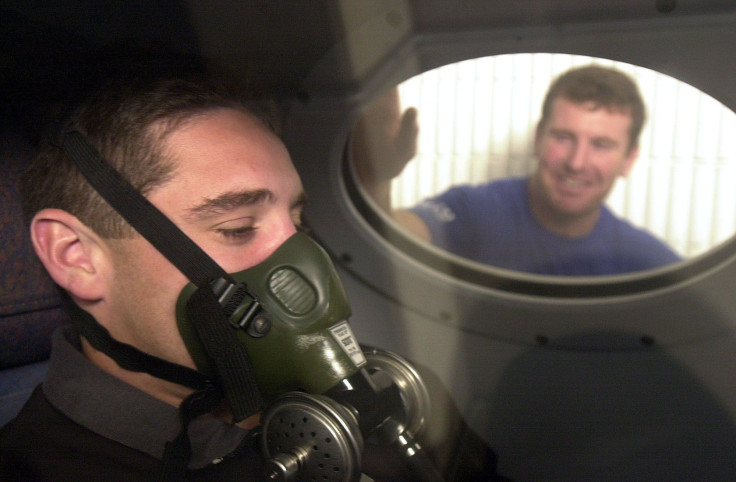Hyperbaric Oxygen Therapy Reverses Toddler’s Brain Damage Who Almost Drowned

Eden Carlson, a toddler who almost drowned in a swimming pool and sustained severe brain damage in February 2016, regained her normal way of life after she was administered Hyperbaric Oxygen Therapy for a prolonged period of time, which reversed her neurological impairments.
In what could be the first case in medical history, HBOT saved the life of the two-year-old who was discovered face-down, floating in her family’s swimming pool just a day before her birthday. After struggling in the cold water for 10 minutes, Eden’s heart beat slowed down and it was almost non-existent, NBC-affiliate WGRZ reported. Even though she was alive after being resuscitated at the Arkansas Children’s Hospital, her brain functions were hampered to the point where she could not move or talk, according to her medical report.
Healthline describes oxygen therapy as “supplemental oxygen given to the people who, largely due to breathing disorders, aren’t able to get enough naturally.” While the particular treatment is often taken for granted, it has proven effective for patients suffering from an array of illnesses such as Chronic Obstructive Pulmonary Disease (COPD), pneumonia, asthma, bronchopulmonary dysplasia, heart failure, cystic fibrosis, sleep apnea, lung disease and respiratory trauma.
Read: Comets Produce Their Own Oxygen, Planets Could Do The Same Without Needing Life
Some of the symptoms of low oxygen in blood are shortness of breath, speeding heart rate, discoloration of the skin, coughing, sweating and disorientation. The normal levels of oxygen in the blood should ideally be between 75 and 100 mmHg and should not go beyond 110 mmHg. If blood oxygen level equals 60 mmHg or drops lower, an individual can sustain severe damage to his or her brain cells.

During her treatment, when Eden's MRI scan revealed she sustained cerebral atrophy with gray and white matter loss, Dr. Paul Harch, Clinical Professor and Director of Hyperbaric Medicine at LSU Health New Orleans School of Medicine, was consulted. That is when Eden was advised to go for HBOT, which exposes a patient to pure oxygen using a carefully controlled pressurized chamber. The therapy is supposed to flood the human body with three times the normal amount of oxygen, according to the Food and Drug Administration.
Harch recommended the family to let Eden undergo prolonged HBOT. After two months of following the treatment, that is breathing pure oxygen at sea-level pressure for 45 minutes, five days a week, the toddler regained muscle control as well as her ability to speak, walk and respond to commands. “The startling regrowth of tissue in this case occurred because we were able to intervene early in a growing child, before long-term tissue degeneration,” Harch said in a statement.
Today Eden can climb stairs and play like any toddler of her age would. Further explaining the miraculous reversal of brain damage, Harch stated: "Every time you [have HBOT], we are manipulating gene expression in a beneficial way, inhibiting cell death and inflammation while promoting tissue growth and repair." The videos of her recovery have been put on a YouTube channel — Eden Carlson Miracles.
However, seeing a complete regrowth of the lost brain tissue is extremely rare, something that was possible in Eden’s case because of her young age. “You have a growing child, a hormone-rich brain and stimulation in this setting. And the result is that we were able to demonstrate an obvious and large re-growth of brain tissue that is inarguably the result of this therapy,” Harch said, according to a Health Day report.

Harch describes HBOT as the "most misunderstood therapy in the history of science." One reason could be it has not ever been clearly explained how the treatment brings positive results, he said.
"In fact, there are now four other trials that have come out, all in adults, that indicate that you can reduce the death rate of acute brain injury patients by nearly 50 to 60 percent if you apply this in the first week after injury," Harch added, making it clear that age is not an issue when it comes to carrying out the oxygen therapy. "So I want to encourage doctors to look at this therapy," he said. "The downside is so minimal. But the potential benefit is incredibly encouraging."
Read: Climate Change Is Causing The Dissolved Oxygen In World's Oceans To Plummet
Harch, along with Dr. Edward Fogarty, at the University of North Dakota School of Medicine, have published their findings based on the incident in a study, that delves into the possibilities of HBOT.
However, FDA warns the HBOT has not been clinically proven to treat cancer, autism and diabetes, diseases. “Patients may incorrectly believe that these devices have been proven safe and effective for uses not cleared by FDA, which may cause them to delay or forgo proven medical therapies," Nayan Patel, a biomedical engineer in FDA's Anesthesiology Devices Branch, has been quoted as saying in a section dedicated to the therapy on the FDA website. "In doing so, they may experience a lack of improvement and/or worsening of their existing condition(s)."
© Copyright IBTimes 2024. All rights reserved.












